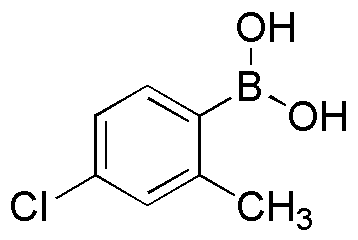4-Chloro-2-methylphenylboronic acid is widely utilized in research focused on:
- Organic Synthesis: This compound serves as a key intermediate in the synthesis of various organic molecules, particularly in the development of pharmaceuticals and agrochemicals. Its boronic acid functionality allows for versatile coupling reactions, enhancing the efficiency of chemical synthesis.
- Drug Development: In medicinal chemistry, it is used to create compounds with potential therapeutic effects. Its ability to form stable complexes with biomolecules makes it valuable in the design of targeted drug delivery systems.
- Materials Science: The compound is employed in the development of advanced materials, such as polymers and nanomaterials. Its unique properties facilitate the creation of materials with enhanced mechanical and thermal characteristics.
- Bioconjugation: It is utilized in bioconjugation techniques, allowing researchers to attach biomolecules to surfaces or other molecules. This application is crucial in the development of biosensors and diagnostic tools.
- Chemical Sensors: The compound is also used in the fabrication of chemical sensors due to its ability to selectively bind to specific analytes. This property is beneficial in environmental monitoring and safety applications.
General Information
Properties
Safety and Regulations
Applications
4-Chloro-2-methylphenylboronic acid is widely utilized in research focused on:
- Organic Synthesis: This compound serves as a key intermediate in the synthesis of various organic molecules, particularly in the development of pharmaceuticals and agrochemicals. Its boronic acid functionality allows for versatile coupling reactions, enhancing the efficiency of chemical synthesis.
- Drug Development: In medicinal chemistry, it is used to create compounds with potential therapeutic effects. Its ability to form stable complexes with biomolecules makes it valuable in the design of targeted drug delivery systems.
- Materials Science: The compound is employed in the development of advanced materials, such as polymers and nanomaterials. Its unique properties facilitate the creation of materials with enhanced mechanical and thermal characteristics.
- Bioconjugation: It is utilized in bioconjugation techniques, allowing researchers to attach biomolecules to surfaces or other molecules. This application is crucial in the development of biosensors and diagnostic tools.
- Chemical Sensors: The compound is also used in the fabrication of chemical sensors due to its ability to selectively bind to specific analytes. This property is beneficial in environmental monitoring and safety applications.
Documents
Safety Data Sheets (SDS)
The SDS provides comprehensive safety information on handling, storage, and disposal of the product.
Product Specification (PS)
The PS provides a comprehensive breakdown of the product’s properties, including chemical composition, physical state, purity, and storage requirements. It also details acceptable quality ranges and the product's intended applications.
Certificates of Analysis (COA)
Search for Certificates of Analysis (COA) by entering the products Lot Number. Lot and Batch Numbers can be found on a product’s label following the words ‘Lot’ or ‘Batch’.
Numéro de catalogue
Numéro de lot/série
Certificates Of Origin (COO)
This COO confirms the country where the product was manufactured, and also details the materials and components used in it and whether it is derived from natural, synthetic, or other specific sources. This certificate may be required for customs, trade, and regulatory compliance.
Numéro de catalogue
Numéro de lot/série
Safety Data Sheets (SDS)
The SDS provides comprehensive safety information on handling, storage, and disposal of the product.
DownloadProduct Specification (PS)
The PS provides a comprehensive breakdown of the product’s properties, including chemical composition, physical state, purity, and storage requirements. It also details acceptable quality ranges and the product's intended applications.
DownloadCertificates of Analysis (COA)
Search for Certificates of Analysis (COA) by entering the products Lot Number. Lot and Batch Numbers can be found on a product’s label following the words ‘Lot’ or ‘Batch’.
Numéro de catalogue
Numéro de lot/série
Certificates Of Origin (COO)
This COO confirms the country where the product was manufactured, and also details the materials and components used in it and whether it is derived from natural, synthetic, or other specific sources. This certificate may be required for customs, trade, and regulatory compliance.


